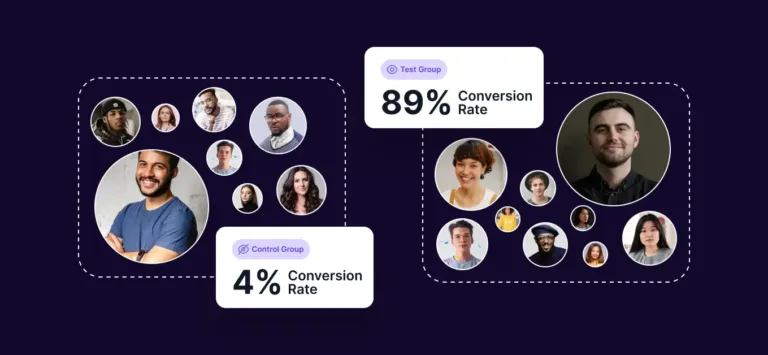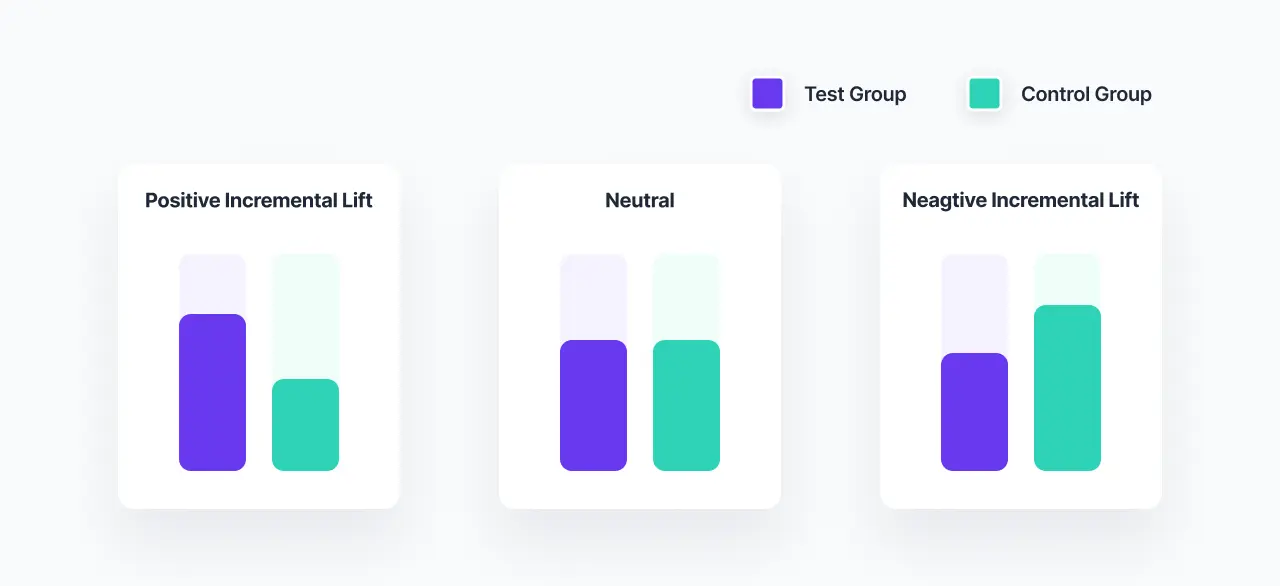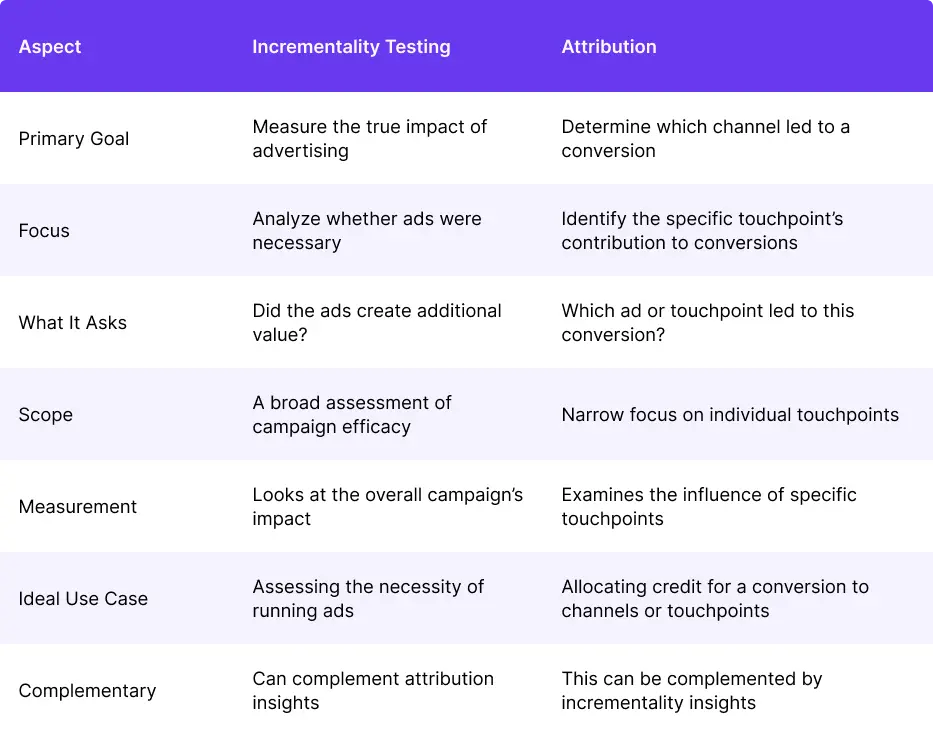More than 98% of brands in the United States use paid advertising to acquire customers. But how can they know whether their ads are necessary?
What if a brand can get as many customers without spending anything on ads?
A/B testing would not help you answer this question as you are testing a channel and not merely a component.
So what is the solution?
Incrementality Testing.
What is Incrementality Testing and How It Helps?
The name might sound fancy, but the concept is straightforward. Incrementality testing measures the actual return on investment (ROI) of your advertising efforts, stripping away the confusion and ambiguity between organic traffic and paid conversions. This clarity allows you to make smarter, more informed decisions.
Let’s break it down with a simple example:
Meet ModernTrend – Your trendy fashion ecommerce brand
Imagine you run ModernTrend, a flourishing ecommerce brand specializing in trendy fashion. You’re about to launch a new line of clothing, and you decide to invest in an advertising campaign to promote it. You run various ad creatives on social media and other platforms, aiming to drive sales.
After a month, you analyze the results and find two things:
1) Some customers made purchases through your ad campaigns
2) Others bought your new clothing line directly through your website without interacting with your ads.
Now, you want to understand the true impact of your advertising campaign. This is where incrementality testing steps in.
Divide and Conquer
Incrementality testing follows a scientific method. First, it splits your target audience into two groups:
1) The Test Group:
This group gets to see your ads. These are the individuals who engaged with your advertising campaigns and made purchases as a result.
2) The Control Group:
This group is kept separate for analysis and doesn’t see your ads. These are the customers who bought your clothing without any interaction with your ads.
By comparing the results from each group, you can see which conversions would not have occurred without your advertising. This difference is expressed as a percentage and is known as “incremental lift.”
The Three Possible Outcomes
Incrementality experiments usually result in one of three scenarios:
1) Positive Incremental Lift:
This is the best-case scenario. It means your test group (those who interacted with your ads) outperformed the control group. In simple terms, your campaign was a hit and led to increased revenue for your business.
2) Neutral:
Sometimes, your test and control groups produce the same results. In this case, your campaign generated sales, but there was no noticeable lift from your ads. It’s a sign that you might need to tweak your strategy, like changing your ads content or targeting.
3) Negative Incremental Lift:
In rare cases, your campaign can do more harm than good. It results in a negative incremental lift, indicating that your advertising is impacting your brand negatively. This situation prompts a closer look at your testing setup.
A graphic showcasing the different possible outcomes of incrementality testing
A graphic showcasing the different possible outcomes of incrementality testing
The Pros and Cons of Incrementality Testing
To make informed decisions about when and how to implement incrementality testing, it’s essential to understand both sides of the coin–the pros and cons.
The Pros:
- Precision in Measurement: Incrementality testing is a scientific approach to gauge the true impact of your advertising efforts. It provides a precise measurement of how your ads influence consumer behavior, eliminating guesswork.
- Channel Effectiveness: This method helps you assess the effectiveness of various advertising channels. It’s invaluable when you’re considering new platforms or experimenting with different ad networks, allowing you to allocate your budget strategically.
- Budget Optimization: By comparing the conversions from paid advertising to organic traffic you can determine whether your ad spend is justified. It reveals whether your budget could be redistributed to more fruitful channels or campaigns.
- Re-Engagement Insights: For re-engagement campaigns, incrementality testing provides crucial insights into the optimal timing, channels, and messaging. This ensures that your efforts yield the highest incremental lift when reconnecting with your audience.
- Privacy Compliance: In the era of privacy-focused changes, such as Apple’s ATT framework, incrementality testing is an essential tool for brands. It helps you adapt to these shifts by providing data-driven insights while respecting user privacy.
The Cons:
- Complexity: Setting up and conducting incrementality tests can be complex. It requires technical expertise, significant data management, and precise configurations. Managing these intricacies can be a challenge.
- Resource-Intensive: Incrementality testing demands a considerable investment of resources. Connecting to ad network APIs, aggregating data, and ensuring statistical significance can be time-consuming and costly.
- Noise and External Factors: External factors can skew results. Seasonal variations or unexpected events might impact user behavior and confound your data. Ensuring clean and noise-free results is a constant challenge.
- Segment Size: The size of the segments used in testing should be significant enough to yield meaningful results. Striking the right balance between segment size and test duration can be tricky.
- Technical Know-How: Incrementality testing requires a certain level of technical proficiency. Brands may need to invest in training or collaborate with experts to ensure accurate and reliable results.
Incrementality Testing vs Attribution: Unraveling the Differences
Understanding the impact of your advertising is like navigating a maze. You not only need to know if your campaigns are working but also whether they’re essential. Attribution and incrementality testing, both play a role here. However, they serve different purposes.
The Core Distinction
The key distinction between these two approaches is their primary question.
Incrementality testing seeks to determine whether your advertising had a genuine impact and if it was even necessary. It’s like asking, “Would we have achieved these results without our ads?”
On the other hand, attribution is all about identifying which specific ad or touchpoint contributed to a conversion. It answers, “Which part of our marketing efforts led the customer to take action?”
While incrementality testing provides a broad perspective on the campaigns efficacy, attribution delves into the influence of each touchpoint. They aren’t mutually exclusive; in fact, they can complement each other. By combining insights from both approaches, you get a more comprehensive understanding of your marketing impact.
Here’s a straightforward table breaking down the differences between the two approaches:
A tabular comparison of incrementality testing and attribution
A tabular comparison of incrementality testing and attribution
So, when you need to assess the value of your advertising efforts, you turn to incrementality testing, When you want to pinpoint which ad or touchpoint played a crucial role in conversions, attribution is your guide. These two tools work together to help you navigate the ever-changing landscape of digital marketing effectively.
When to Use Incrementality Testing: Unlocking the Power of Precision
Disclaimer: These are just some of the instances where incrementality testing can be made the best use of. You can possibly explore more use cases of incrementality testing by signing up for a demo of Lifesight’s Incrementality Testing capabilities.
1) Evaluating New Advertising Channels
When a brand is venturing into uncharted advertising territories, incrementality testing is a guiding light. Whether you’re considering a new social media platform, exploring influencer collaborations, or experimenting with emerging ad networks, this method helps you understand if these channels are worth the investment. It reveals the true impact of your ads, ensuring you’re not pouring money into a venture that might not yield substantial results.
2) Optimizing Ad spend
Every brand aims to maximize its return on ad spend (ROAS). Incrementality testing empowers you to identify areas where your ad budget is underperforming and make adjustments. By comparing the conversions from paid advertising to organic traffic, you can gauge whether your budget allocation aligns with actual results. If your ads aren’t generating incremental value, it’s time to redistribute resources for better outcomes.
3) Enhancing Re-Engagement Strategies
Engaging existing customers is often more cost-effective than acquiring new ones. Here’s where incrementality testing takes center stage. For re-engagement campaigns, this method becomes a game-changer. It helps you pinpoint the ideal channels, messages, and timing to reconnect with your audience. With these insights, you can optimize your re-engagement strategy to achieve the highest incremental lift, ensuring your marketing efforts reach their full potential.
4) Adapting to Privacy-Driven Changes
In the age of privacy-focused updates, like Apple’s ATT framework under iOS14, traditional measurement methods might fall short. Incrementality testing becomes crucial in filling the gap left by changes in tracking and attribution. It provides a data-driven approach to ensure your brand makes smart, privacy-compliant decisions. By understanding the real impact of your campaigns, you can navigate these shifting landscapes with confidence.
5) A/B testing vs. Incrementality Testing
While A/B testing helps compare different versions of ads, incrementality testing goes a step further. In A/B testing, you might compare a blue button to a red button in a banner ad. Incrementality testing, however, evaluates whether running that banner ad at all is better than not running it. This approach is invaluable when you need to assess whether your ads are genuinely necessary or if you could achieve the same results without them.
Conclusion: Unlock the Power of Incrementality Testing
As a marketer, it’s crucial to make every penny of your ad spend count. That’s where incrementality testing steps into the spotlight.
This methodology, grounded in scientific principles, separates the wheat from the chaff, letting you know definitively whether your advertising efforts are driving incremental value.
The power of incrementality testing goes beyond mere metrics; it’s about informed decision-making. Whether you’re dealing with user acquisition or re-engagement, determining the effectiveness of new media channels, or optimizing your budget allocation, this method gives you the insights to confidently shape your marketing strategies.
Now, how can you make the most of incrementality testing for your brand? That’s where Lifesight’s incrementality testing solution steps in as your trusted partner.
With our automated incremental lift tests, you’ll find the validation you need to confidently navigate the multi-channel marketing landscape, especially in this privacy-first era. We empower modern marketers by enabling them to harness their own data for model-informed strategies, execute audience split tests, and run geo-experiments seamlessly.
Lifesight offers the tools to scale up your spend with assurance, helping you discover growth opportunities, and allocate budgets accurately. You can automatically build actionable scenarios based on your budget or KPIs, optimize on a channel level or for your entire funnel, and ensure that every move you make is a strategic one.
Take the first step towards more confident, data-driven decision-making. Join the ranks of industry leaders like Ray-Ban, LG, Spotify, and many more who have benefited from Lifesight’s incrementality testing capabilities.
Request a demo now and let Lifesight guide you toward more effective, efficient, and impactful marketing campaigns.
You may also like
Essential resources for your success
























































